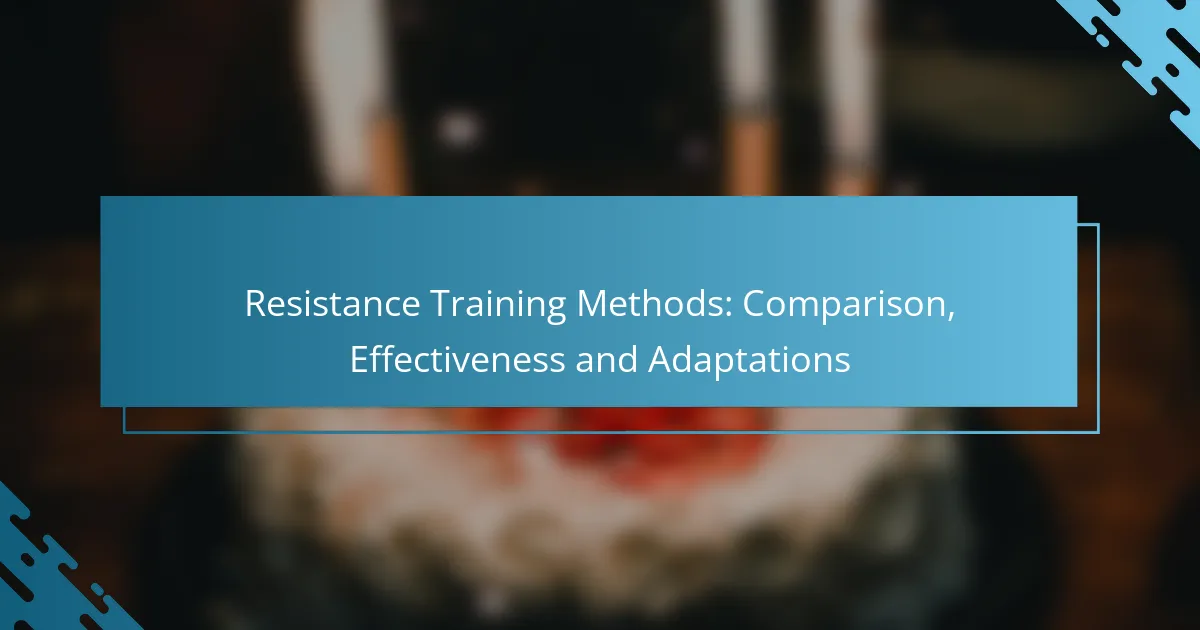Resistance training encompasses various methods such as free weights, bodyweight exercises, resistance bands, machines, and circuit training, each offering distinct advantages tailored to individual fitness goals. Understanding the effectiveness of these methods is crucial for optimizing strength gains, muscle hypertrophy, and overall health benefits. By selecting the appropriate approach, individuals can enhance their physical performance and promote long-term wellness.

What Are the Most Effective Resistance Training Methods?
The most effective resistance training methods include free weights, bodyweight exercises, resistance bands, machines, and circuit training. Each method offers unique benefits and can be tailored to individual goals, fitness levels, and available equipment.
Free Weights
Free weights, such as dumbbells and barbells, are versatile tools that allow for a wide range of exercises targeting multiple muscle groups. They require stabilization from the user, which can enhance core strength and functional fitness.
When using free weights, focus on proper form to prevent injury. Start with lighter weights and gradually increase the load as strength improves. Aim for 8-12 repetitions per set for muscle hypertrophy.
Bodyweight Exercises
Bodyweight exercises utilize your own weight as resistance, making them accessible and effective for all fitness levels. Common examples include push-ups, squats, and pull-ups, which can be performed anywhere without equipment.
To increase difficulty, you can modify these exercises or add variations, such as single-leg squats or explosive push-ups. Aim for 2-3 sets of 10-15 repetitions to build strength and endurance.
Resistance Bands
Resistance bands provide variable resistance throughout the range of motion, making them a great option for both beginners and advanced users. They are portable and can be used for a variety of exercises targeting different muscle groups.
When incorporating resistance bands, ensure they are securely anchored and choose bands with appropriate tension for your strength level. Perform 2-3 sets of 10-15 repetitions for effective muscle engagement.
Machines
Resistance machines offer guided movements that can help isolate specific muscles, making them ideal for beginners or those recovering from injury. They often include adjustable weights and settings to accommodate various body sizes and strength levels.
While machines can be effective, they may limit functional strength development. Use them as part of a balanced routine alongside free weights and bodyweight exercises, aiming for 8-12 repetitions per set.
Circuit Training
Circuit training combines multiple exercises performed in succession with minimal rest, promoting cardiovascular fitness and muscular endurance. This method can include a mix of free weights, bodyweight exercises, and machines.
To create a circuit, select 5-10 exercises targeting different muscle groups and perform each for a set time or number of repetitions. Rest for 1-2 minutes between circuits and aim for 2-4 rounds for a comprehensive workout.

How Do Resistance Training Methods Compare?
Resistance training methods vary in their effectiveness based on goals such as strength gains, muscle hypertrophy, accessibility, and cost-effectiveness. Understanding these differences helps individuals choose the right approach for their fitness journey.
Strength Gains
Different resistance training methods can lead to varying levels of strength gains. Traditional weightlifting, for instance, typically emphasizes heavy loads and low repetitions, which are effective for building maximal strength. In contrast, bodyweight exercises may enhance functional strength but might not yield the same peak strength levels as heavy lifting.
For optimal strength development, consider incorporating compound movements like squats and deadlifts, which engage multiple muscle groups. Aim for a rep range of 1-6 for strength-focused workouts, adjusting weights to ensure the last repetitions are challenging.
Muscle Hypertrophy
Muscle hypertrophy, or muscle growth, is often best achieved through resistance training methods that focus on moderate weights and higher repetitions. Techniques such as progressive overload and varying training volume can stimulate muscle fibers effectively.
A common approach for hypertrophy is to work within a rep range of 6-12, allowing for sufficient time under tension. Incorporating isolation exercises, like bicep curls or tricep extensions, can also target specific muscles to enhance growth.
Accessibility
Accessibility of resistance training methods can significantly impact adherence and success. Bodyweight exercises, such as push-ups and squats, can be performed anywhere without equipment, making them highly accessible for beginners or those with limited resources.
On the other hand, gym-based resistance training may require access to specific equipment and facilities. For individuals in urban areas, gyms may be readily available, while those in rural settings might find bodyweight training or resistance bands more practical.
Cost-Effectiveness
Cost-effectiveness is a crucial factor when choosing resistance training methods. Bodyweight training and resistance bands are generally low-cost or free options, making them ideal for those on a budget. In contrast, gym memberships and purchasing weights can add up over time.
When evaluating cost, consider the long-term investment. A home gym setup may require an initial expense but can save money over time compared to ongoing gym fees. Weigh the benefits of convenience and accessibility against the financial commitment to find the best fit for your situation.

What Are the Benefits of Resistance Training?
Resistance training offers numerous benefits, including increased muscle strength, improved metabolic rate, enhanced injury prevention, and better bone density. These advantages contribute to overall health, physical performance, and longevity.
Improved Muscle Strength
Resistance training is highly effective for building muscle strength through the application of external resistance, such as weights or resistance bands. Engaging in exercises like squats, deadlifts, and bench presses can lead to significant strength gains over time.
To maximize strength improvements, aim for 2-3 sessions per week, focusing on major muscle groups. Gradually increase the weight or resistance as your strength progresses to continue challenging your muscles.
Enhanced Metabolic Rate
Resistance training can elevate your metabolic rate, helping you burn more calories even at rest. This effect occurs because muscle tissue requires more energy to maintain than fat tissue, leading to increased calorie expenditure.
Incorporating resistance training into your routine can boost your metabolism by 15-30% for several hours post-exercise. Combining it with aerobic activities can further enhance overall caloric burn and weight management.
Injury Prevention
Engaging in resistance training can significantly reduce the risk of injuries by strengthening muscles, tendons, and ligaments. A well-structured program improves joint stability and enhances overall functional fitness.
To prevent injuries, focus on proper form and technique during exercises. Incorporate a variety of movements that target different muscle groups, and allow adequate recovery time between sessions to avoid overuse injuries.
Bone Density Improvement
Resistance training is beneficial for improving bone density, which is crucial for preventing osteoporosis, especially in older adults. Weight-bearing exercises stimulate bone formation and help maintain bone strength.
To enhance bone health, include resistance exercises at least twice a week, targeting all major muscle groups. Consider incorporating activities like weightlifting, bodyweight exercises, or resistance bands to promote bone density effectively.

What Factors Influence Resistance Training Adaptations?
Resistance training adaptations are influenced by several key factors, including training volume, frequency, intensity, and rest periods. Understanding these elements can help optimize training outcomes and achieve specific fitness goals.
Training Volume
Training volume refers to the total amount of work performed in a training session, typically measured as sets multiplied by repetitions. Higher training volumes can lead to greater muscle hypertrophy, while lower volumes may be sufficient for strength gains. A common recommendation is to aim for 10-20 sets per muscle group per week for optimal results.
When planning training volume, consider your experience level and recovery capacity. Beginners may benefit from lower volumes, while advanced lifters often require higher volumes to continue making progress. Tracking your volume can help identify what works best for you.
Frequency
Frequency is the number of training sessions per muscle group within a given timeframe, usually a week. Training a muscle group 2-3 times weekly is often effective for most individuals, allowing for adequate recovery while promoting consistent stimulus for growth.
Higher frequency can enhance muscle protein synthesis and improve overall performance. However, it’s essential to balance frequency with recovery needs. If you experience fatigue or soreness, consider adjusting your training schedule to allow for proper rest.
Intensity
Intensity in resistance training refers to the amount of weight lifted relative to your maximum capability. Higher intensity, typically defined as lifting 70% or more of your one-repetition maximum (1RM), is crucial for building strength and power. Moderate intensities can be effective for hypertrophy.
When determining intensity, consider your goals. For strength, focus on heavier weights with lower repetitions; for muscle growth, moderate weights with higher repetitions may be more beneficial. Adjusting intensity can help prevent plateaus and keep your training challenging.
Rest Periods
Rest periods between sets significantly impact training adaptations. Shorter rest periods (30-60 seconds) can enhance muscular endurance and metabolic stress, while longer rest periods (2-5 minutes) are typically better for strength and power training, allowing for full recovery between sets.
Choosing the right rest period depends on your training goals. For hypertrophy, aim for moderate rest times to maximize muscle fatigue; for strength, prioritize longer rests to ensure optimal performance in subsequent sets. Monitoring your rest can help you tailor your workouts effectively.

How to Choose the Right Resistance Training Method?
Selecting the right resistance training method depends on your specific fitness goals and experience level. Understanding these factors will help you tailor your workouts for optimal results.
Fitness Goals
Your fitness goals significantly influence the resistance training method you should choose. For instance, if your aim is to build muscle mass, methods like hypertrophy training with moderate weights and higher repetitions may be effective. Conversely, if your goal is to improve strength, focusing on lower repetitions with heavier weights is advisable.
Consider whether you want to enhance endurance, power, or overall fitness. Endurance training typically involves lighter weights and higher repetitions, while power training requires explosive movements with heavier loads. Aligning your method with your goals will streamline your progress.
Experience Level
Your experience level plays a crucial role in determining the appropriate resistance training method. Beginners should start with basic bodyweight exercises or light weights to establish proper form and technique. Gradually increasing the intensity and complexity of workouts is essential to avoid injury.
Intermediate and advanced lifters can explore more specialized techniques, such as supersets, drop sets, or periodization. These methods can provide new challenges and stimulate further adaptations. Always assess your current capabilities and progress to ensure you are choosing a method that matches your level of experience.
